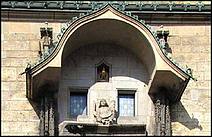
Symbology of the past … or the present as well?
We are stepping onto thin ice, or onto
quicksand. We are entering the area of ancient and mysterious symbols,
depictions of animals and mythic beings and their interpretations. This
area extends across civilizations and cultures of Europe and Far East
as well as the transatlantic ones. They often attributed different
interpretations to the symbols because a symbol that had a positive
meaning within one culture could have a negative nature in a different
one. The symbol itself, transformed within a given culture, also needs
its counterpart; only then can the comparison and difference between
the positive and negative be clearly perceived.
New ideologies appropriate some of the symbols but alter most of them and attribute them a different meaning. This is how the new Christian ideology developed before the end of the Roman era. Bearing this in mind while thinking about medieval symbology, we often discover crucial discrepancies between understanding the symbols in ancient Egypt, Babylonia or Europe. And then there are civilizations of the Far East or transatlantic cultures, which were known very little, if at all, at those times.
According to a commonly accepted view, the end of the Middle Ages and beginning of the modern period is marked by Christopher Columbus’ discovery of America in 1492. This date is interesting for Prague as well. At that time, the first known veduta of the town was created (1493, a woodcarving in the Schedel’s Chronicle), and the astronomical clock was improved by Jan Růže, to whom the authorship of the machine was attributed for almost five hundred years. It would be more precise to shift the beginning of the modern period a few decades back, to the moment when Gutenberg invented the printing press. That is when the medieval information revolution began and when the Church, as the ruling ideology, promptly recognized that its monopoly of spoken and written word had come to an end. At first, it considered printers to be “black craftsmen”, having nothing to do with stains of printing ink but with a craft associated with infernal powers. However, the Church adapted quickly; the first prints were mostly prints of the Bible.
We take the ideology of the medieval Christian Europe as the basis for the approach to the astronomical clock, with occasional digression to pre-Christian mythology. We will try to tame our imagination as we are no mysteriologists, nor esotericists.



